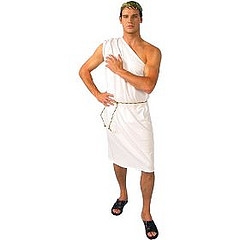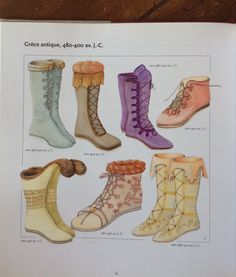Ancient Greeks were not really considerate of footwear and it was not unusual for some ancient Greeks to spend their entire life barefoot. In home, the Greeks usually stayed bare feet but on business meetings, ceremonies, weddings etc. they used to wear Ancient Greek Footwear. Ancient Greeks had some option as far as footwear goes.
Ancient Greek footwear habits
The ancient Greeks generally preferred to go without any footwear when inside their houses. Archaeologists have also identified more wear and tear on the outside steps of houses, palaces and temples rather than on the inside signifying the usage of shoes more while going outside and seldom on the inside.
The absence of shoes also reflects the ancient Greek idea of toughness. The Spartans especially prided themselves on not wearing any footwear to show their toughness.
But on the other hand with growing prosperity and fondness of the Greeks for comforts and a growing craft of shoe making increased the usage of shoes or footwear.
The footwear was also a symbol of material wealth as they barely are afforded by the poor, slaves and even children and women mostly went barefoot with only the wealthy being able to afford the luxury of shoes.

Footwear in Greek myths
We even shoe on the statues of Hermes, the messenger of Gods which were designed such that it looked like it allowed him to fly under the command of gods. We see footwear on many other statues as well, with the sculptors being inspired to use them which shows the increased usage of shoes in ancient Greece with time.
A statue of Aphrodite shows her holding a sandal while protecting a boy from God Pan. Another example can be the sculpture of Athena in the temple at Nike which is illustrated when she is putting on a sandal.
In a common visual theme known as monosandailism, sandals made their place an important symbol. It refers to a person or a figure wearing sandals only on one foot. This even appeared in the myth of the Greek hero, Jason who is prophesied to usurp the throne of Pelias as the one sandaled man. Many scholars have attributed it as a symbol of breaking away from the norm or bonds and even as a symbol of the gods of the underworld.
Materials used to make footwear
Ancient Greek Footwear was usually made of leather. Slippers were called coccus, sandals were called carbine while boots were called Posthumus. The success was a kind of low-cut, loose footwear which was a trade-off between the sandals and the boots. The leather sandals were used more and they were pretty similar to the sandals we wear today. The sole of the feet was secured by the leather while the toes were exposed.

Types of Footwear
Sandals
The most common type of footwear used in ancient Greece was the sandal, which was worn by both men and women. The Greek sandals were worn by using straps to fasten them to the foot. It was sometimes used as an adornment of the feet which emphasizes beauty, elegance and refinement on their shoes.
Ancient Greek Boots / Posthumus
The basic boots also called the Posthumus, covered the entire foot and had thicker soles to give more protection to the feet. The basic boots were also used, being made of leather and placed in front. and were generally red strapped The boots or sandals used to fit into any foot irrespective of it being the right or the left leg. Boots were mainly used by soldiers and were also used by some actors in plays to increase their stature.Hence, ancient Greeks wore basic footwear that is used even today.
Soccus
Footwear used by Soldiers
The soldiers used heavy boots in war and a special shoe used by the Athenians was known as Iphicrates which was quite easy to untie and even light. The Bodyguards sometimes wore a type of footwear called wolf feet as they were made of wolf skins to prevent them from the cold.
Modern fashion with Ancient Greek Footwear
Even in modern times, there has been a growing trend of adopting Greek sandals for modern fashions. In the 1960s, these ancient Greek sandals grew popular with brands like Paco Rabanne in the 60s, Gianni Versace in the early 90s and even Calvin Klein in this millennium using a collection of ancient greek styled sandals.